Discovering Precursors to Tropical Cyclone Rapid Intensification in the Atlantic Basin Using Spatiotemporal Data Mining
Abstract
1. Introduction
- Formulate RI and non-RI composite environmental fields from historical TCs. The MERRA2 reanalysis data were collocated with tropical cyclone trajectories in the Atlantic basin, and two RI and non-RI composite groups were built for comparison, in which environmental fields were filtered out from total fields for precursor detection.
- Use clustering to find regions of the tropical cyclone environment that have relatively homogeneous behavior. A shared nearest neighbor clustering approach was utilized to find high quality clusters from 4D environmental data. Each cluster can be represented by a centroid, that is, the mean value describing the grid cells that belong to the cluster; the centroid is a candidate precursor.
- Determine candidate precursors from significantly different regions in RI and non-RI tropical cyclone environmental fields using a spatial statistical method. Many clusters (representing regions in a tropical cyclone environment) in the RI and non-RI groups are not significantly different from each other. We need to detect clusters that are highly different in the two tropical cyclone groups; this can be achieved by examining the differences between cluster centroids.
- Validate potential precursors from candidates by evaluating the impact of candidates on intensity changes. Some precursor candidates may be almost identical to well-known predictors in the SHIPS database, and some candidates may be new potential precursors. If the cluster centroid is comparable to existing predictors in explaining the TC intensity changes, it is one of the potential precursors to the RI events.
2. Data
2.1. SHIPS Database
2.2. MERRA2 Reanalysis Data
2.3. Collocation
2.4. Environmental Data Filter
3. Methods
3.1. An SNN-Based Clustering Approach
- A similarity graph is built by computing pair-wise similarities for all pairs of points (grid cells in our case) and sparsified by keeping the k most similar neighbors of each point.
- An SNN graph is constructed from the sparse similarity graph using sNN-similarity, which is defined as the number of points in the intersection of the k nearest neighbor list of two points.
- Given a parameter eps (eps < k), the sNN-density of each point is computed from the SNN graph. The sNN-density of a point P is defined as the number of points having sNN-similarity to P at least eps. A point whose sNN-density is not less than another parameter MinPts (MinPts < k) is a core point.
- Two core points are placed in the same cluster if they are within a radius eps of each other (that is, their sNN-similarity is larger than eps). All non-core points that are not within a radius of eps of any core point are discarded as noise. Every non-core, non-noise point is assigned to a cluster to which its nearest core point belongs and is regarded as a border point in the cluster.
3.2. SNN Clustering of Tropical Cyclone Environmental Fields
3.3. Detect Potential Precursors from Clusters
3.4. Validation of Potential Precursors
4. Analysis
4.1. 200 hPa Zonal Wind
4.2. 850–700 hPa Relative Humidity
4.3. 850–200 hPa Vertical Wind Shear
5. Conclusions
Author Contributions
Funding
Institutional Review Board Statement
Informed Consent Statement
Acknowledgments
Conflicts of Interest
References
- Zhang, W.; Villarini, G.; Vecchi, G.A.; Smith, J.A. Urbanization exacerbated the rainfall and flooding caused by hurricane Harvey in Houston. Nature 2018, 563, 384–388. [Google Scholar] [CrossRef] [PubMed]
- Aberson, S.D. Five-Day Tropical Cyclone Track Forecasts in the North Atlantic Basin. Weather Forecast. 1998, 13, 1005–1015. [Google Scholar] [CrossRef]
- Aberson, S.D. The Ensemble of Tropical Cyclone Track Forecasting Models in the North Atlantic Basin (1976–2000). Bull. Am. Meteorol. Soc. 2001, 82, 1895–1904. [Google Scholar] [CrossRef][Green Version]
- Kormahalleh, M.M.; Sefidmazgi, M.G.; Homaifar, A. A sparse recurrent neural network for trajectory prediction of Atlantic hurricanes. In Proceedings of the Genetic and Evolutionary Computation Conference, Denver, CO, USA, 20–24 July 2016; pp. 957–964. [Google Scholar]
- Ash, K.D.; Matyas, C.J. The influences of ENSO and the subtropical Indian Ocean Dipole on tropical cyclone trajectories in the southwestern Indian Ocean. Int. J. Clim. 2010, 32, 41–56. [Google Scholar] [CrossRef]
- DeMaria, M. A Simplified Dynamical System for Tropical Cyclone Intensity Prediction. Mon. Weather Rev. 2009, 137, 68–82. [Google Scholar] [CrossRef]
- DeMaria, M.; Sampson, C.R.; Knaff, J.A.; Musgrave, K.D. Is tropical cyclone intensity guidance improving? Bull. Am. Meteorol. Soc. 2014, 95, 387–398. [Google Scholar] [CrossRef]
- Emanuel, K. Tropical cyclones. Annu. Rev. Earth Planet. Sci. 2003, 31, 75–104. [Google Scholar] [CrossRef]
- Kaplan, J.; DeMaria, M.; Knaff, J. A Revised Tropical Cyclone Rapid Intensification Index for the Atlantic and Eastern North Pacific Basins. Weather Forecast. 2010, 25, 220–241. [Google Scholar] [CrossRef]
- Kaplan, J.; Rozoff, C.M.; Sampson, C.; Kossin, J.P.; Velden, C.S.; DeMaria, M.; Leighton, P. Improvements to the SHIPS Rapid Intensification Index: A Year-2 JHT Mid-term Report; University of Wisconsin-Madison: Madison, WI, USA, 2013. [Google Scholar]
- Kaplan, J.; Rozoff, C.M.; DeMaria, M.; Sampson, C.R.; Kossin, J.; Velden, C.S.; Cione, J.J.; Dunion, J.P.; Knaff, J.; Zhang, J.; et al. Evaluating Environmental Impacts on Tropical Cyclone Rapid Intensification Predictability Utilizing Statistical Models. Weather. Forecast. 2015, 30, 1374–1396. [Google Scholar] [CrossRef]
- Rozoff, C.M.; Kossin, J.P. New probabilistic forecast models for the prediction of tropical cyclone rapid intensification. Weather. Forecast. 2011, 26, 677–689. [Google Scholar] [CrossRef]
- Holliday, C.R.; Thompson, A.H. Climatological Characteristics of Rapidly Intensifying Typhoons. Mon. Weather Rev. 1979, 107, 1022–1034. [Google Scholar] [CrossRef]
- Grimes, A.; Mercer, A.E. Synoptic-Scale Precursors to Tropical Cyclone Rapid Intensification in the Atlantic Basin. Adv. Meteorol. 2015, 2015, 814043. [Google Scholar] [CrossRef]
- Elsberry, R.L.; Lambert, T.D.B.; Boothe, M.A. Accuracy of Atlantic and Eastern North Pacific Tropical Cyclone Intensity Forecast Guidance. Weather Forecast. 2007, 22, 747–762. [Google Scholar] [CrossRef]
- Montgomery, M.T.; Bell, M.M.; Aberson, S.D.; Black, M.L. Hurricane Isabel (2003): New insights into the physics of intense storms. Part I: Mean vortex structure and maximum intensity estimates. Bull. Am. Meteorol. Soc. 2006, 87, 1335–1347. [Google Scholar] [CrossRef]
- Bosart, L.F.; Velden, C.S.; Bracken, W.E.; Molinari, J.; Black, P.G. Environmental Influences on the Rapid Intensification of Hurricane Opal (1995) over the Gulf of Mexico. Mon. Weather Rev. 2000, 128, 322. [Google Scholar] [CrossRef]
- Yang, R.; Tang, J.; Kafatos, M. Improved associated conditions in rapid intensifications of tropical cyclones. Geophys. Res. Lett. 2007, 34. [Google Scholar] [CrossRef]
- Wang, Y.; Rao, Y.; Tan, Z.-M.; Schönemann, D. A Statistical Analysis of the Effects of Vertical Wind Shear on Tropical Cyclone Intensity Change over the Western North Pacific. Mon. Weather Rev. 2015, 143, 3434–3453. [Google Scholar] [CrossRef]
- Su, H.; Wu, L.; Zhai, C.; Jiang, J.H.; Neelin, J.D.; Yung, Y.L. Observed Tightening of Tropical Ascent in Recent Decades and Linkage to Regional Precipitation Changes. Geophys. Res. Lett. 2020, 47, e2019GL085809. [Google Scholar] [CrossRef]
- DeMaria, M.; Kaplan, J. A Statistical Hurricane Intensity Prediction Scheme (SHIPS) for the Atlantic Basin. Weather Forecast. 1994, 9, 209–220. [Google Scholar] [CrossRef]
- Yang, R.; Tang, J.; Sun, D. Association Rule Data Mining Applications for Atlantic Tropical Cyclone Intensity Changes. Weather Forecast. 2011, 26, 337–353. [Google Scholar] [CrossRef]
- Rew, R.; Davis, G. NetCDF: An interface for scientific data access. IEEE Comput. Graph. Appl. 1990, 10, 76–82. [Google Scholar] [CrossRef]
- Stonebraker, M.; Becla, J.; DeWitt, D.J.; Lim, K.T.; Maier, D.; Ratzesberger, O.; Zdonik, S.B. Requirements for Science Data Bases and SciDB. In Proceedings of the CIDR 2009 Fourth Biennial Conference on Innovative Data Systems Research, Asilomar, CA, USA, 4–7 January 2009. [Google Scholar]
- Kurihara, Y.; Bender, M.A.; Ross, R.J. An Initialization Scheme of Hurricane Models by Vortex Specification. Mon. Weather Rev. 1993, 121, 2030–2045. [Google Scholar] [CrossRef]
- Faber, V. Clustering and the continuous k-means algorithm. Los Alamos Sci. 1994, 22, 67. [Google Scholar]
- Schubert, E.; Sander, J.; Ester, M.; Kriegel, H.P.; Xu, X. DBSCAN revisited, revisited: Why and how you should (still) use DBSCAN. ACM Trans. Database Syst. 2017, 42, 1–21. [Google Scholar] [CrossRef]
- Indyk, P.; Motwani, R. Approximate Nearest Neighbors: Towards Removing the Curse of Dimensionality. In Proceedings of the Thirtieth Annual ACM Symposium on Theory of Computing, Dallas, TX, USA, 24–26 May 1998. [Google Scholar]
- Kumari, S.; Maurya, S.; Goyal, P.; Balasubramaniam, S.S.; Goyal, N. Scalable Parallel Algorithms for Shared Nearest Neighbor Clustering in High Performance Computing (HiPC). In Proceedings of the 2016 IEEE 23rd International Conference on High Performance Computing (HiPC), Hyderabad, India, 19–22 December 2016. [Google Scholar]
- Ertöz, L.; Steinbach, M.; Kumar, V. Finding Clusters of Different Sizes, Shapes, and Densities in Noisy, High Dimensional Data. In Proceedings of the 2003 SIAM International Conference on Data Mining, San Francisco, CA, USA, 1–3 May 2003. [Google Scholar]
- Ertoz, L.; Steinbach, M.; Kumar, V. A New Shared Nearest Neighbor Clustering Algorithm and Its Applications. In Proceedings of the Workshop on Clustering High Dimensional Data and Its Applications at 2nd SIAM International Conference on Data Mining, Arlington, VA, USA, 13 April 2002. [Google Scholar]
- Wilks, D.S. Statistical Methods in the Atmospheric Sciences: An Introduction; Academic Press: Cambridge, MA, USA, 1995. [Google Scholar]


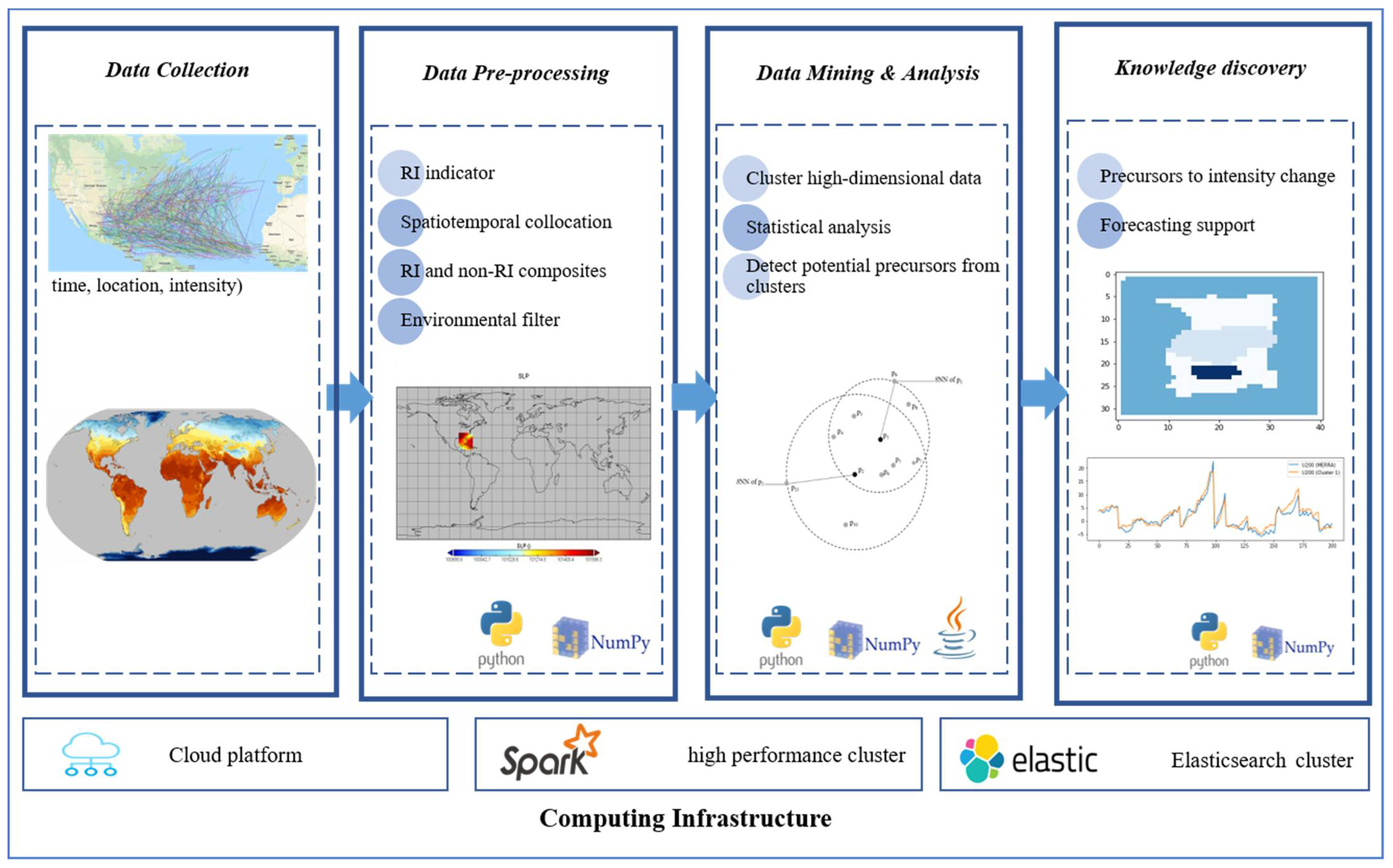
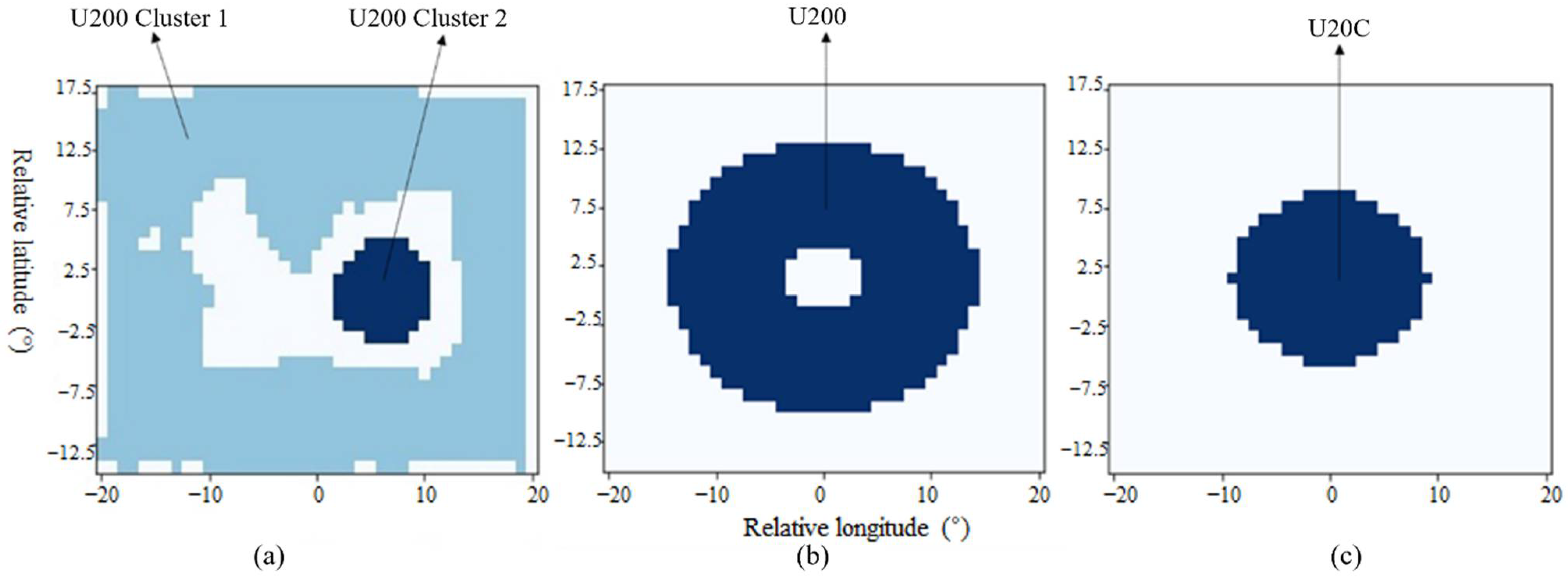
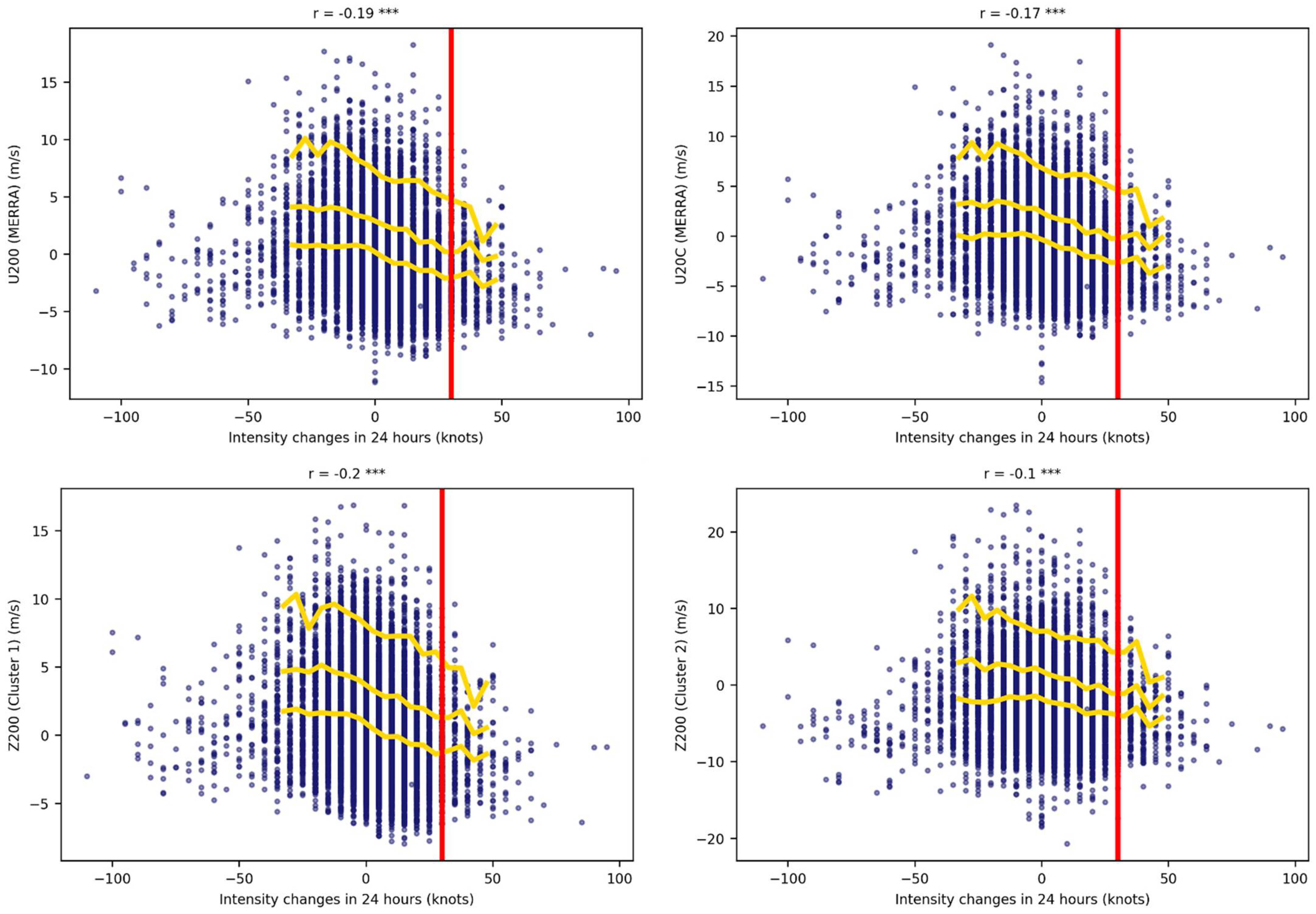

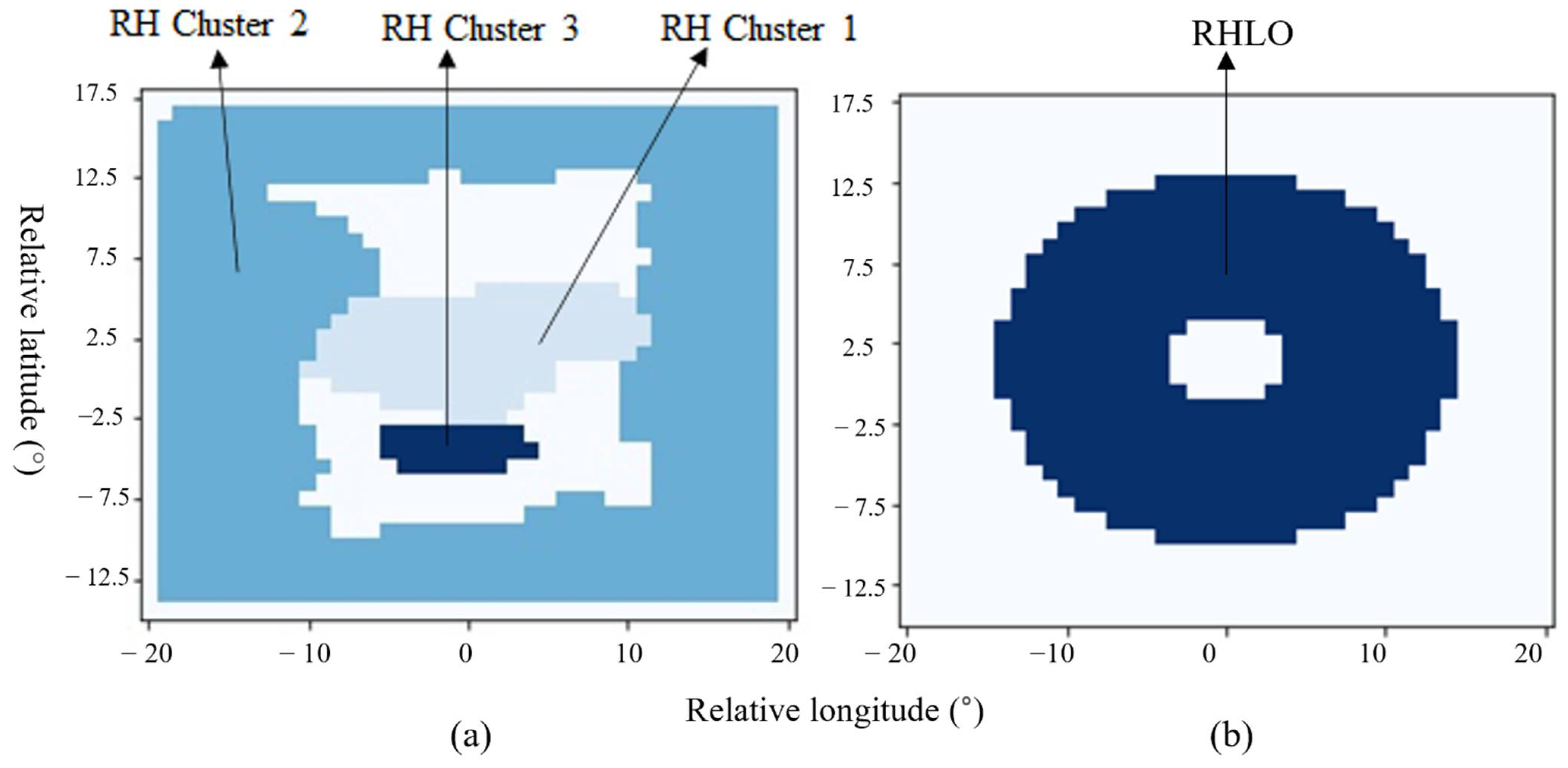
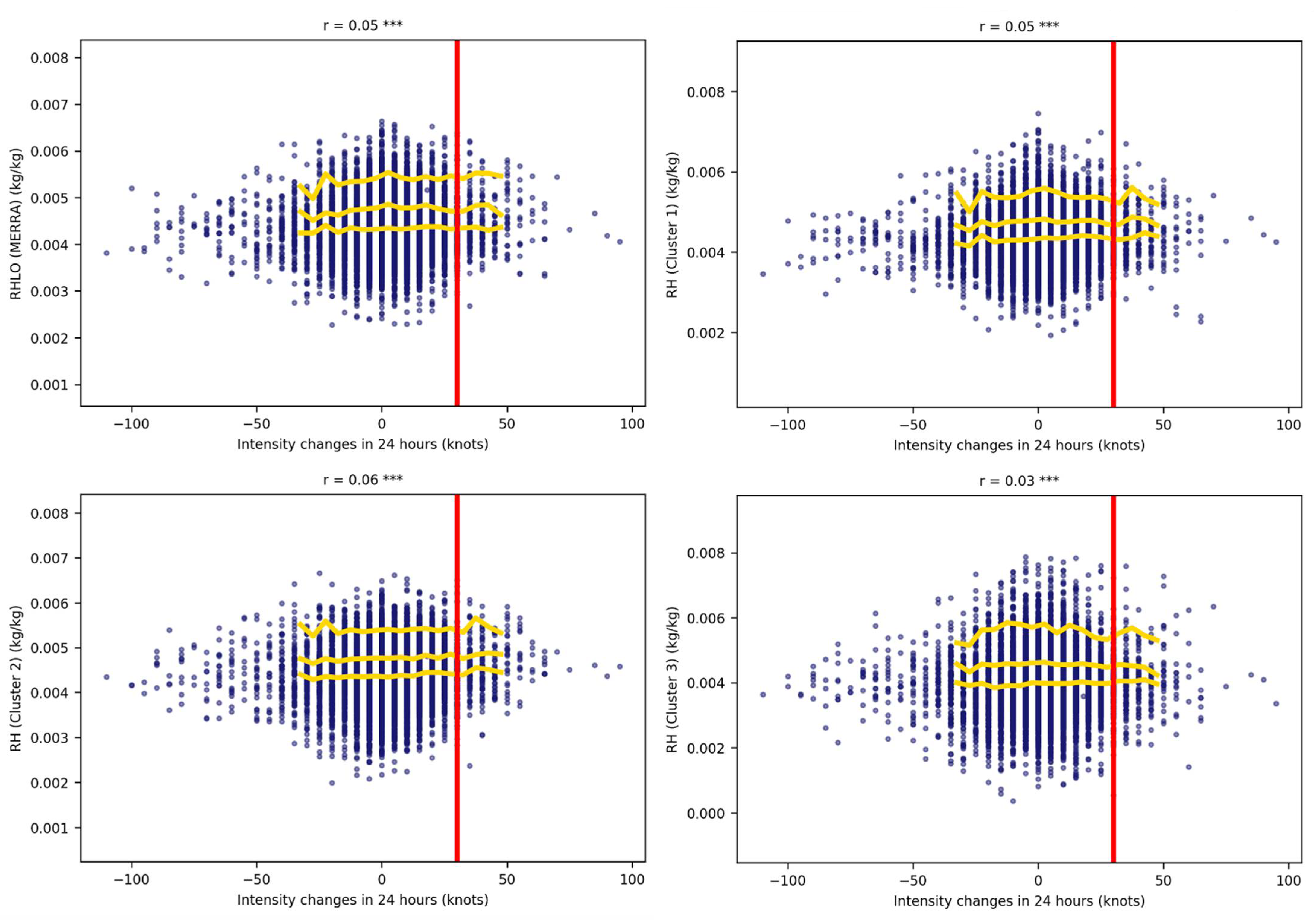
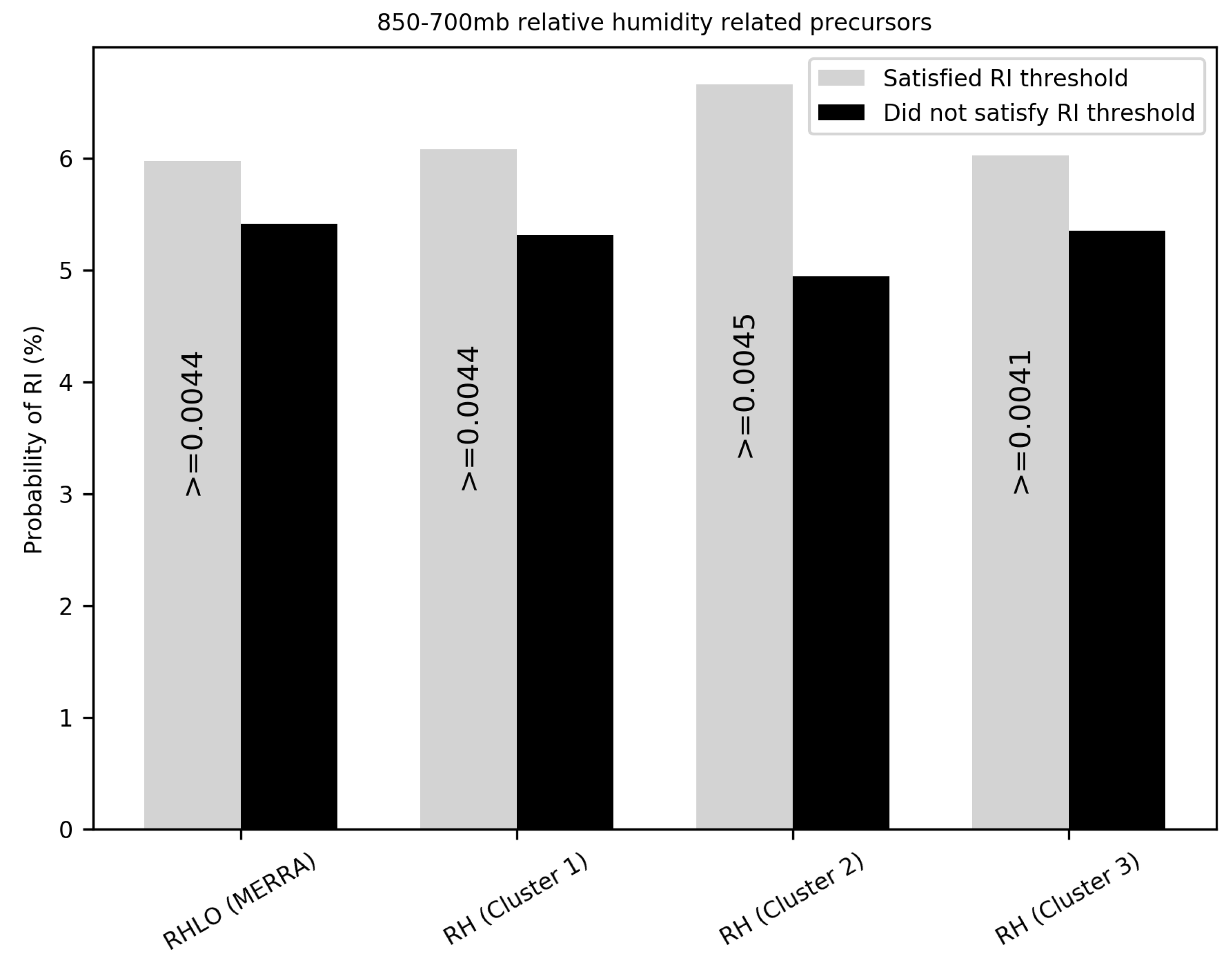
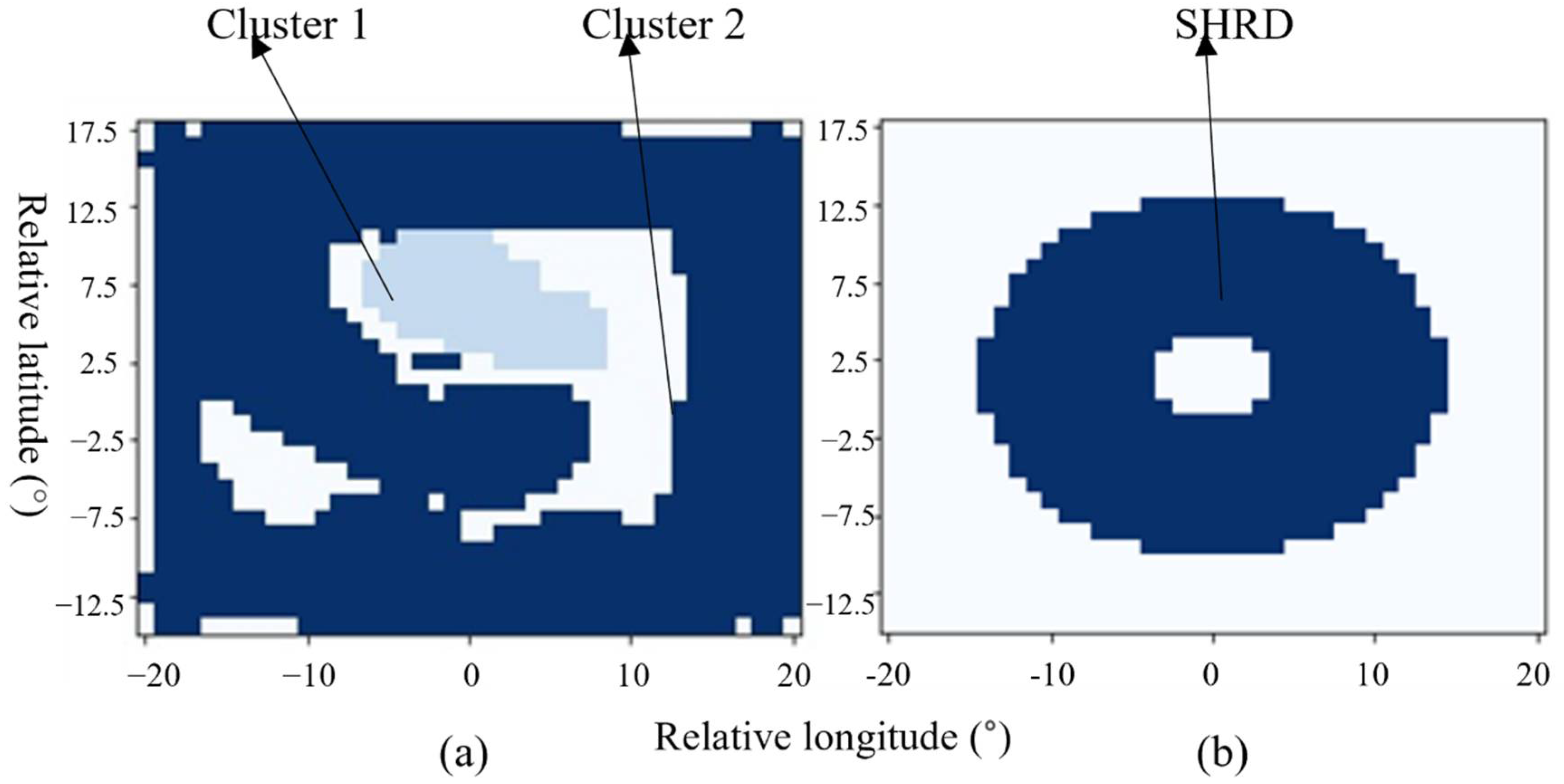
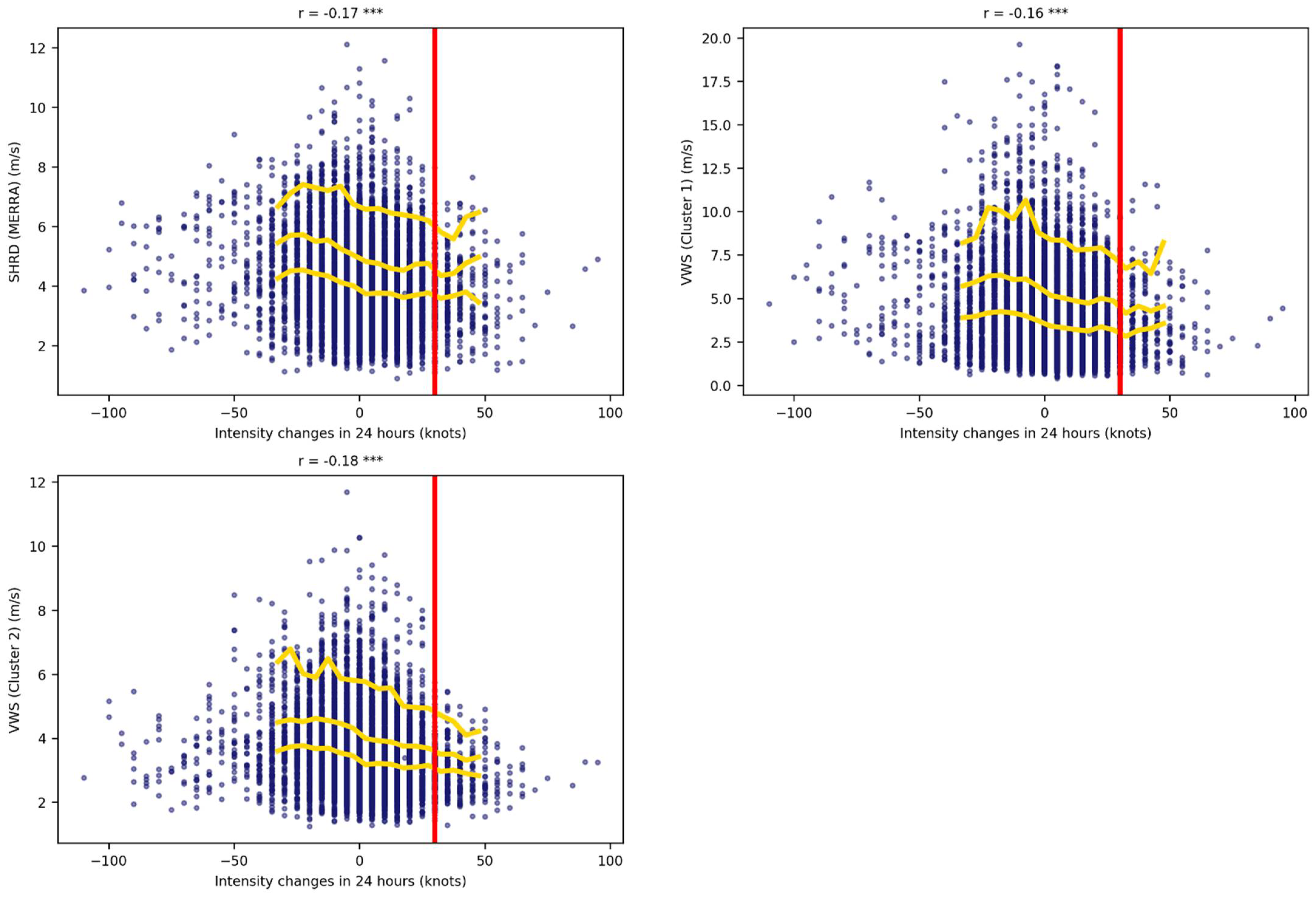
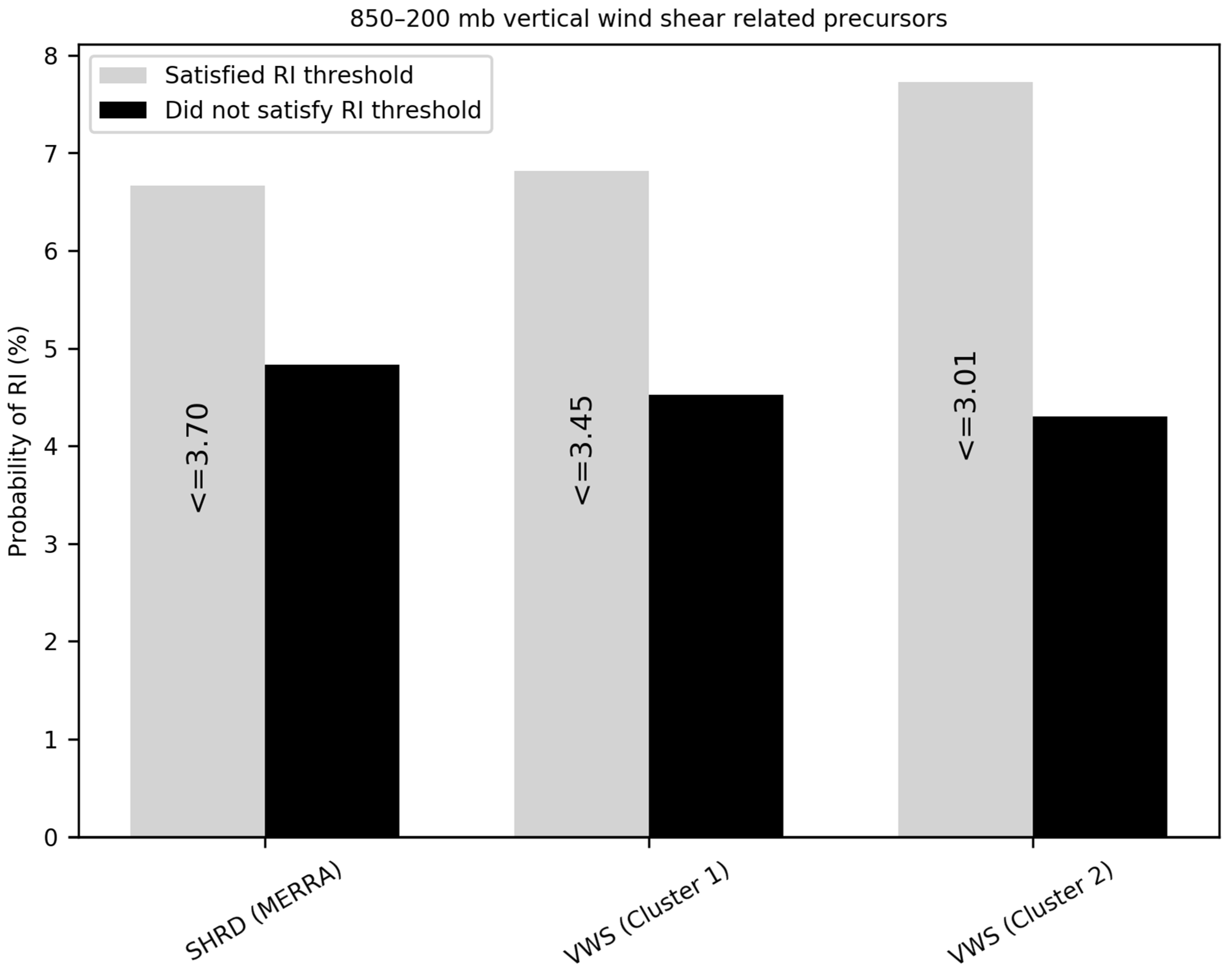
| Predictor Name | Description |
|---|---|
| LAT | Storm latitude |
| LON | Storm longitude |
| VMAX | Max sustained surface wind |
| U200 | 200 hPa zonal wind (r = 200–800 km) |
| U20C | As for U200, but for (r = 0–500 km) |
| SHRD | 850–200 hPa sheer magnitude (10 kt) vs. time (200–800 km) |
| RHLO | 850–700 hPa relative humidity vs. time (200–800 km) |
| No. | Name | Year | Month | Date | Time | LAT | LON | RI |
|---|---|---|---|---|---|---|---|---|
| 1 | ALBE | 1982 | 6 | 2 | 12 | 217 | 871 | Yes |
| 2 | ALBE | 1982 | 6 | 2 | 18 | 222 | 865 | Yes |
| 3 | ALBE | 1982 | 6 | 3 | 0 | 226 | 858 | Yes |
| 4 | ALBE | 1982 | 6 | 3 | 6 | 228 | 850 | No |
| Short Name | Spatial Resolution | Temporal Resolution | Level | Variable |
|---|---|---|---|---|
| M2I6NVANA | 0.5° × 0.625° | 6 h | 72 | QV (specific humidity) |
| U (eastward wind component) | ||||
| V (northward wind component) |
Publisher’s Note: MDPI stays neutral with regard to jurisdictional claims in published maps and institutional affiliations. |
© 2022 by the authors. Licensee MDPI, Basel, Switzerland. This article is an open access article distributed under the terms and conditions of the Creative Commons Attribution (CC BY) license (https://creativecommons.org/licenses/by/4.0/).
Share and Cite
Li, Y.; Yang, R.; Su, H.; Yang, C. Discovering Precursors to Tropical Cyclone Rapid Intensification in the Atlantic Basin Using Spatiotemporal Data Mining. Atmosphere 2022, 13, 882. https://doi.org/10.3390/atmos13060882
Li Y, Yang R, Su H, Yang C. Discovering Precursors to Tropical Cyclone Rapid Intensification in the Atlantic Basin Using Spatiotemporal Data Mining. Atmosphere. 2022; 13(6):882. https://doi.org/10.3390/atmos13060882
Chicago/Turabian StyleLi, Yun, Ruixin Yang, Hui Su, and Chaowei Yang. 2022. "Discovering Precursors to Tropical Cyclone Rapid Intensification in the Atlantic Basin Using Spatiotemporal Data Mining" Atmosphere 13, no. 6: 882. https://doi.org/10.3390/atmos13060882
APA StyleLi, Y., Yang, R., Su, H., & Yang, C. (2022). Discovering Precursors to Tropical Cyclone Rapid Intensification in the Atlantic Basin Using Spatiotemporal Data Mining. Atmosphere, 13(6), 882. https://doi.org/10.3390/atmos13060882








